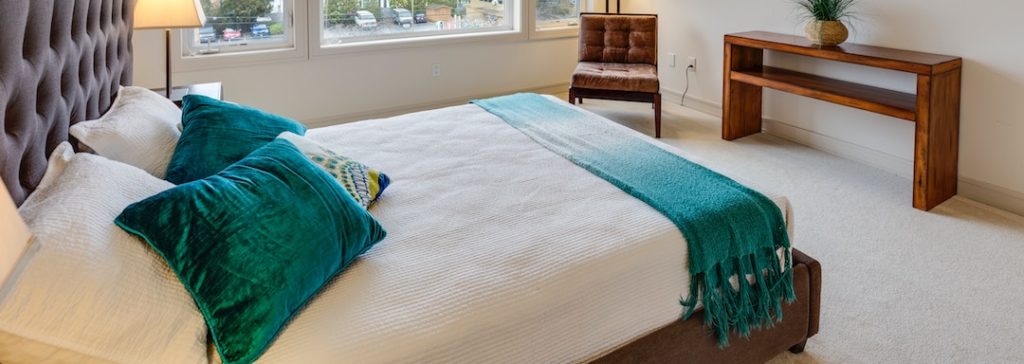Organic all-latex mattresses are some of the safest and most eco-friendly models on the market. However, they’re not common, and it can be hard to tell if they’re truly organic. Terms like green, all-natural, organic, and eco-friendly are often used interchangeably, but they don’t always mean the same thing.
For the purposes of this article, when we say organic latex mattresses, we’re generally talking about models with comfort, transition, and support layers made of certified organic latex. Because these types of mattresses are few and far between, we also include natural latex mattresses made in organic-certified facilities.
The latex may not be certified organic because of the rigor of the standards, but the facility has to meet certain standards such as no use of harmful chemicals like formaldehyde, PBDEs, and heavy metals. That means the latex is either free from or low in these chemicals and low in VOCs. This article includes three of the best organic latex mattresses as well as a guide to help you as you’re shopping for the best mattress.
Best Latex Mattresses
| Mattress | Highlights | Price |
|---|---|---|
| Amerisleep Organica | Features a responsive medium feel with buoyant coils. | $2099 |
| PlushBeds Botanical Bliss | Features firm, but bouncy all-natural Dunlop latex. | $2199 |
| Spindle | Features customizable layers to find your ideal firmness. | $1600 |
| Essentia Stratami | Offers zoned support within the latex layers. | $2249 |
1. Amerisleep Organica
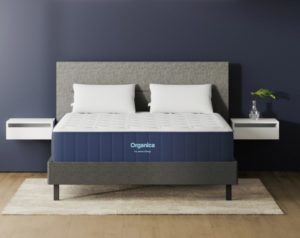 The Amerisleep Organica is available as a medium mattress, excellent for any back, side, or combination sleepers seeking a natural mattress. The Organica stands 13 inches tall and has a list of certifications testifying to the quality of its materials, yet is available at an affordable price.
The Amerisleep Organica is available as a medium mattress, excellent for any back, side, or combination sleepers seeking a natural mattress. The Organica stands 13 inches tall and has a list of certifications testifying to the quality of its materials, yet is available at an affordable price.
The mattress’s certifications include the Global Organic Textile Standard, the Rainforest Alliance, eco-INSTITUT, and the OEKO-TEX® Standard 100:
- The Global Organic Textile Standard (GOTS) certifies yarn as organic, examining the process of a fabric’s creation.
- The Rainforest Alliance examines products for sustainable impact, as part of their goal to benefit farmers and forest communties.
- The eco-INSTITUT examines the VOC emissions of a product.
- OEKO-TEX® tests for harmful substances in a material.
The mattress’s four layers create a responsive yet cushioning surface, with a durable feel made to last decades. The top layer is an inch of Joma wool, which maintains a cool surface and wicks moisture away from a person. The next layer is inches of responsive, durable Talalay latex. Supporting the top two layers is 8 inches of pocketed coils with added edge support. An inch-thick base of Dunlop latex structures the overall mattress.
The Organica comes in twin, twin XL, full, queen, king, and split king sizes. Amerisleep offers free shipping, a 100-night sleep trial, and a 20-year warranty with every mattress. If the Organica is not the bed for you after you’ve given it a chance, Amerisleep’s customer service will help you donate the mattress and arrange for a full refund.
2. PlushBeds Botanical Bliss
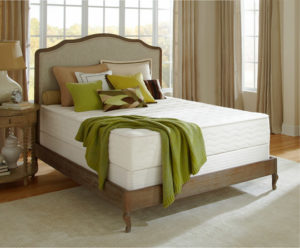 The PlushBeds Botanical Bliss comes in two firmness options— medium and medium-firm— and three heights— 9, 10, and 12 inches. It has a long list of independent certifications ranging from the Global Organic Latex Standard (GOLS) to the eco-INSTITUT and the OEKO-TEX® Standard 100. The GOLS certification alone requires that the latex be 95 percent organically produced.
The PlushBeds Botanical Bliss comes in two firmness options— medium and medium-firm— and three heights— 9, 10, and 12 inches. It has a long list of independent certifications ranging from the Global Organic Latex Standard (GOLS) to the eco-INSTITUT and the OEKO-TEX® Standard 100. The GOLS certification alone requires that the latex be 95 percent organically produced.
The Botanical Bliss starts with a GOTS (Global Organic Textile Standard) certified organic cotton cover that’s breathable, soft, and comfortable. Underneath is a layer of certified organic wool that helps regulate sleeper temperature while improving cushioning.
In the nine and ten-inch models, this wool layer is followed by three aerated layers of organic Dunlop latex. The 12-inch model has a fourth layer of Dunlop latex. Dunlop latex has a denser, firmer feel than Talalay latex, but that added density gives it better durability. The Botanical Bliss also comes in dual comfort layers, which means couples can have different firmnesses on each side of the mattress.
PlushBeds offers a 100-night sleep trial. If you don’t like the mattress, the manufacturer will arrange for curbside pickup. The Botanical Bliss also comes with a prorated 25-year warranty that covers body impressions deeper than 1.5 inches and defects in the latex. After year 10, PlushBeds charges the customer a percentage of the original mattress’s price to replace the defective model.
3. Spindle Natural Latex Mattress
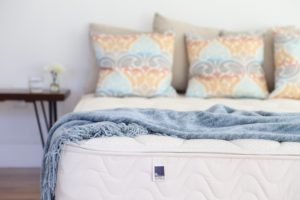 Spindle takes a unique approach to mattress design by shipping the mattress in layers that are then assembled at home by the customer. On the one hand, it’s more work for the customer. On the other, you get a custom-built mattress based on your comfort preferences.
Spindle takes a unique approach to mattress design by shipping the mattress in layers that are then assembled at home by the customer. On the one hand, it’s more work for the customer. On the other, you get a custom-built mattress based on your comfort preferences.
The Spindle Natural Latex mattress can be ordered in soft, medium, and firm. Based on your firmness choice, you’re sent the mattress’s layers and cover with each delivered in an individual box. The order in which the layers are assembled affects the final firmness and feel of the mattress.
Spindle uses Dunlop latex that’s OEKO-TEX and Rainforest Alliance Certified. The OEKO-TEX Standard 100 certification means that the entire mattress has been tested and found free of harmful levels of chemicals. The Rainforest Alliance certification has to do with the sustainability of the rubber trees where the sap for the latex is harvested.
Spindle offers a 365-day comfort adjustment, which is a sleep trial period. They recommend a 60-day break-in period. Within that time, if you don’t like the mattress, it can be returned. However, Spindle may also suggest changing the order of the layers to adjust the firmness level.
Spindle’s mattresses also come with a 10-year warranty that covers indentations over ¾ of an inch, but it also has a 25-year comfort renewal program. For up to 25 years after you purchase the mattress, you can contact Spindle, and they’ll replace layers that have lost their comfort. However, the replacement layers come with a fee.
4. Essentia Stratami Mattress
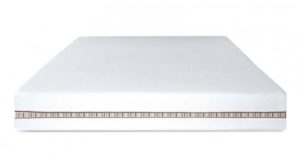 Essentia calls the Stratami an organically-built mattress rather than an organic mattress. Their factories are GOLS and GOTS certified. That means there are no chemical flame retardants, poly-foams, or toxic chemicals found in-factory or in the mattress. The latex is natural but not GOLS certified, but the cover is GOTS certified, which means it’s made of at least 70 percent organic materials.
Essentia calls the Stratami an organically-built mattress rather than an organic mattress. Their factories are GOLS and GOTS certified. That means there are no chemical flame retardants, poly-foams, or toxic chemicals found in-factory or in the mattress. The latex is natural but not GOLS certified, but the cover is GOTS certified, which means it’s made of at least 70 percent organic materials.
Essentia uses a unique three-inch latex comfort layer, wherein the latex is cut into dome-shaped channels. The domes run the width of the mattress and are arranged in zones to better support the differing support needs of the shoulders, hips, and waist. The dome shape eliminates the need for wool or extra cotton in the comfort layer.
The domes are followed by a five-inch latex support core. Overall, the Stratami provides a responsive, contouring sleep for those looking for a mattress that’s less prone to off-gassing and safer for the environment.
The Stratami comes with a 120-night trial period and a limited 20-year warranty that covers indentations over ¾ of an inch.
Mattress Types to Consider
Mattresses fall into four broad types. Each type has its pros and cons and may work better for different sleep positions and sleepers of different sizes and weights.
Memory Foam Mattresses
Memory foam is made with polyurethane foam that’s been treated by chemicals to give it a viscoelastic feel. More eco-friendly memory foam contains some plant oils in place of petroleum— and it still has the ability to stretch and conform under pressure and heat. That ability to change, conform, and adjust to the sleeper’s individual shape makes it feel as though the memory foam partially surrounds your body. It relieves pressure and changes shape as the sleeper moves throughout the night.
Every mattress manufacturer has their own memory foam formula to give their foams unique properties. Memory foam can also be made in different densities and firmnesses. However, memory foam mattresses may alternate latex or poly-foam layers with the memory foam layers. Memory foams of different densities, firmnesses, and structures can be used to create mattresses that fall anywhere on the firmness scale from soft to firm.
When memory foam first came to the mattress market, it often trapped body heat and caused overheating. Today’s manufacturers use a variety of techniques to improve the breathability and temperature neutrality of their memory foams. They may add or infuse the foam with gel, copper, or graphite, which absorb heat and move it away from the body.
Memory foam works well for most sleep positions because it adapts to each sleeper’s individual shape. They’re also comfortable mattresses for side sleepers who need pressure relief at the shoulders and hips. However, stomach sleepers need firmer memory foam to prevent too much sinkage in the hips.
Latex Mattresses
Both natural and synthetic latex are used to make mattresses. The latex is processed using either the Dunlop or Talalay method. Talalay latex is typically found in the comfort and transitions layers of the mattress because of its lighter, more responsive feel. Latex support layers are usually made of Dunlop latex due to its firmer feel.
Latex mattresses may also be made of synthetic, man-made latex, which is not derived from the sap of the rubber tree like the natural variety. Synthetic latex may be used alone or mixed with natural latex during the manufacturing process. While synthetic latex mimics the feel of natural latex, it’s less durable and breaks down faster.
Latex’s cushioning abilities allow latex layers to be used as an alternative to memory foam. However, latex contours to the body but doesn’t necessarily conform as closely as memory foam. It returns to its original shape faster, giving it a bouncier, more responsive feel. However, like memory foam, it can trap heat. For that reason, it’s aerated with channels or sculpted into shapes that promote airflow and enhance breathability.
Latex works well for sleepers, especially side sleepers, who prefer contouring over snug conformability. It also offers a bouncy, more responsive feel for those who don’t like to sink into their mattress.
Innerspring Mattresses
Innerspring mattresses have an internal coil support system with a quilted top for comfort. Some have memory or poly-foam quilted to the cover or a pillow or Euro top to further cushion the body.
The coils within the system vary in design from low cost continuous and Bonnell coils to the individually-wrapped pocketed coils found in more expensive mattresses. Coils come in different gauges, which affects how firm they are. Mattresses may even have zoned coils so there’s more support in the back and less in the shoulders. Firmer coils are often found around the edge of the mattress to prevent sagging.
Innersprings come in all firmness levels, though they offer stiffer support than memory foam or latex beds. Side sleepers will probably prefer the targeted pressure relief of pocketed coils while back and stomach sleepers may be comfortable with the firmer and less expensive varieties like continuous or Bonnell coils. Overall, coils tend to be stiffer with more response to sleeper movement.
Hybrid Mattresses
Hybrids bring the cushioning of foam to the support of coils. The comfort and transition layers of hybrid mattresses contain memory foam, poly-foam, or latex foam. Supporting these layers is a coil support core. The extra space around the coils creates more room for air to flow, so they usually have better breathability than all-foam, mixed foam, or memory foam mattresses. However, the responsiveness of the coils transfers more motion than foam mattresses.
Couples with different mattress preferences may find a hybrid mattress the perfect compromise. Side, back, and combo sleepers also do well with a hybrid’s mix of conforming foam and supportive coils.
Mattress Budget
Mattresses range in price from around $200 to well over $10,000. Affordable budget mattresses start around $200 and go up to around $700. Their comfort may rival more expensive models, but it’s the longevity and durability that suffer at this price point.
Mid-priced models fall in the $700 to $1,200 dollar range. These models offer a balance of comfort and durability. High-end and luxury mattresses start around $1,200 and go up to about $5,000. However, some affordable luxury mattresses, those that have intricate stitching in the cover and high-quality in the interior layers, can start at around $1,000. You’ll find many eco-friendly and/or organic models in this category too.
Premium mattresses fall under the $5,000 to $10,000 range, though you can find models that are much more expensive. Hand stitching, high-end fabrics, all-natural or organic materials, and layers upon layers of premium foams and coils go into the construction of these mattresses. Be wary of some of the mattresses in this category. Some have gold in the thread and brass fittings that do nothing more than add to the price. Make sure you’re not paying for perks that add little to your sleep quality.
Sleeping Position
We all move during the night, but each of us has a preferred sleep position. Different sleep positions need different kinds of support and cushioning, which means you require a mattress that’s tailored to your specific needs.
Side Sleepers
A good mattress should keep your spine in a neutral position from head to tailbone. Side sleepers may have trouble maintaining this position because of the varying pressure points found at the shoulders, waist, hips, and knees. You can’t have the same pressure at your shoulders as you do at the lower back, for example, and expect to stay comfortable all night. The wrong type of support could lead to hip, shoulder, or back pain.
Foams, both memory and latex, work well for side sleepers because they contour and/or conform to each sleeper’s individual shape. Any mattress that can adapt to high-pressure points will be more comfortable for a side sleeper. Also, many of the best mattresses for side sleepers are medium in firmness because they offer a good balance of comfort and support.
Back Sleepers
Sleeping on your back keeps your spine in a neutral position; however, back sleepers still need support in the lower back and shoulders. Comfortable mattresses for back sleepers offer the right amount of cushioning and contouring to keep you in healthy alignment while relieving pressure under the shoulder blades.
Stomach Sleepers
Sleeping on the stomach puts extra pressure on the lower back and, with that, is unrecommended. However, we all move and shift throughout the night, and some of us end up on our stomachs. Stomach sleepers need firmer support that prevents the hips from sinking too far into the mattress. They may also benefit from lighter support in the shoulders, so they can sink slightly to relieve lower back pressure. We recommend firm mattresses for stomach sleepers because they keep the torso lifted and prevent excess stress on your spine.
Sleeping Cool and Airflow
A mattress that traps heat can wake you prematurely or make it hard to fall asleep. Your body temperature drops and fluctuates throughout the night as a regular part of your sleep cycle. If you get too warm, it can cause wakefulness.
Temperature regulation, breathability, and airflow are, therefore, important factors when choosing a mattress. Foams with large, open-cell designs or those infused with gel, copper, and graphite allow air to flow or absorb heat and move it away from the sleeper. Some foams may also have aeration channels, convoluted structures, or cutouts in the surface to create space for heat to escape. Coils of all types also create room for air to flow through and away from the sleeper. Latex is naturally cooling, making them great cooling mattresses for hot sleepers.
Common Questions
Are latex mattresses better?
That depends on what exactly “better” means to you. Latex mattresses can be nearly 100 percent organic and eco-friendly, so in that sense, they can be better than other options if you’re searching for a green mattress. However, not all latex is made the same. Synthetic latex may have as many chemicals as other types of mattress materials. Also, natural latex is sometimes mixed with a small percentage of synthetic latex during the manufacturing process. So, it really depends on the manufacturer and the model.
As far as comfort, that depends on your preferred sleep position, weight, and personal preferences. If you like a responsive mattress that contours to your shape, then a latex bed may be a better choice for you. However, for others, it may not have enough conformability or support.
What is the best Talalay latex mattress?
We can’t pick one model (as everybody has varying sleep needs), but we can tell you how Talalay latex affects the feel of the mattress. Talalay latex has a spongier, bouncier feel than Dunlop. That makes it lighter and highly responsive to movement and changes in sleeping position. However, it’s not as dense or durable as Dunlop.
A mattress with Talalay in the comfort and transition layers will be contouring and quickly move back into shape after the sleeper moves. Some models even allow you to put the layers in a different order to adjust the feel of the mattress. Talalay latex should be supported by a firmer support core of either Dunlop latex, poly-foam, or coils. Otherwise, it may not have the support or longevity you’d like or expect.
What is the best natural latex mattress?
We can’t pick a specific model here, either; but instead, we’ll clarify the term, so you know what you’re looking at when you see a natural latex mattress. Natural latex is derived directly from the liquid sap of the rubber tree.
The term “natural” refers to this natural source versus a synthetic, man-made one. If you want an organic latex mattress, it will, by default, be made of natural latex because only natural latex can be organic.
Conclusion
If you’re looking to cut down on the number of chemicals and limit potential off-gassing, organic latex mattresses are a good way to go. But remember, the best mattress for you is one that helps you sleep for a full seven to nine hours every night. What’s best for you may be different than what’s best for your neighbor or best friend. Take a good look at your sleep style and preferences and rely on sleep trials to make sure you’ve found the right model.
